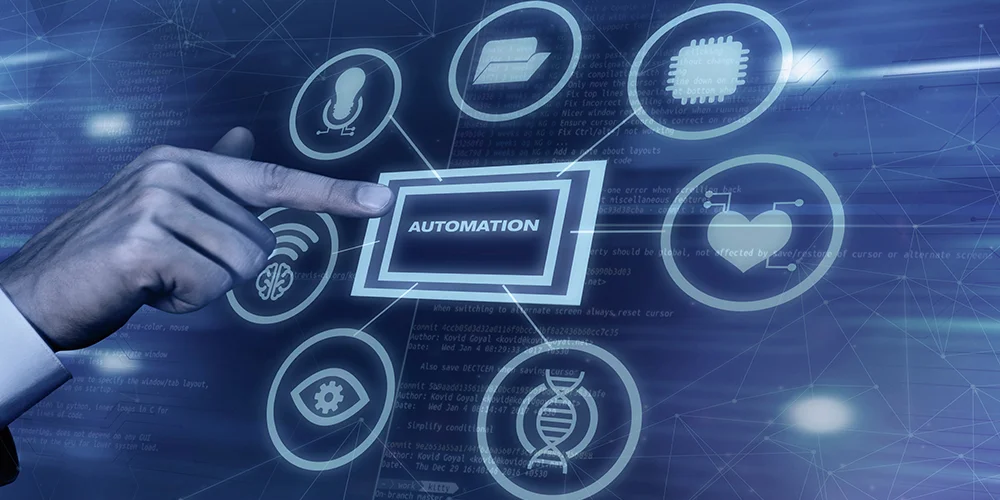Automation: Features, Benefits & How Does it Work, refers to the use of technology and machinery to perform tasks and processes with minimal human intervention. It involves the application of various technologies, such as robotics, computer software, and control systems, to execute repetitive, time-consuming, or complex tasks efficiently and consistently. Automation aims to improve productivity, reduce errors, enhance accuracy, and save time and resources by replacing or augmenting human labor with automated systems.
In the context of automation, tasks can range from simple, repetitive actions, like assembly line operations in manufacturing, to more complex processes, such as data analysis and decision-making in business or controlling industrial processes in chemical plants. Automation can be applied in various industries and sectors, including manufacturing, agriculture, healthcare, transportation, finance, and information technology, to name just a few.
Key components of automation often include sensors to gather data, controllers to make decisions and take actions, and feedback loops to adjust and optimize processes. Additionally, automation can be categorized into different levels, from basic, rule-based automation to advanced systems that incorporate artificial intelligence and machine learning to adapt and improve their performance over time.
Overall, automation plays a crucial role in improving efficiency, reducing costs, and enhancing the quality and consistency of tasks and processes across a wide range of applications.
Types of Automation
Automation can be categorized into several types based on the level of human involvement, the complexity of tasks, and the technologies used.
Here are some common types of automation:
- Fixed Automation (Hard Automation): This type of automation is designed for a specific, dedicated task. The equipment and machinery are set up to perform one repetitive operation, and they cannot easily be reprogrammed or adapted for different tasks. Fixed automation is commonly used in mass production, such as automotive assembly lines.
- Programmable Automation: Programmable automation allows for more flexibility than fixed automation. It involves automated systems that can be reprogrammed or reconfigured to perform different tasks or processes. Manufacturing systems that use Computer Numerical Control (CNC) machines are examples of programmable automation.
- Flexible Automation: Flexible automation is more versatile than both fixed and programmable automation. It involves systems that can adapt to changes in the production process with minimal downtime. Robots with advanced sensors and programming capabilities are often used in flexible automation.
- Industrial Automation: Industrial automation refers to the automation of various industrial processes, including manufacturing, material handling, and quality control. It encompasses a wide range of technologies and systems, including PLCs (Programmable Logic Controllers), SCADA (Supervisory Control and Data Acquisition) systems, and robots.
- Office Automation: Office automation focuses on automating routine office tasks and processes. It includes tools like word processing software, email systems, and document management software. Workflow automation and electronic document management are common examples of office automation.
- Home Automation (Smart Home): Home automation involves the use of technology to control and manage household appliances, lighting, heating, and security systems. Smart thermostats, voice-activated assistants, and home security cameras are examples of home automation.
- Process Automation: Process automation aims to optimize and control complex industrial or business processes. It often involves the use of sensors, controllers, and software systems to monitor and regulate processes, such as chemical manufacturing, power generation, and supply chain management.
- Robotic Automation: Robotic automation refers to the use of robots to perform tasks in various settings, such as manufacturing, healthcare, agriculture, and logistics. Industrial robots, service robots, and collaborative robots (cobots) are all examples of robotic automation.
- Information Technology (IT) Automation: IT automation involves the use of software tools and scripts to automate tasks in IT operations, such as server provisioning, software deployment, and network management. DevOps practices often incorporate IT automation to streamline development and operations processes.
- Artificial Intelligence (AI) and Machine Learning Automation: AI and machine learning automation involve the use of algorithms and data-driven techniques to automate decision-making, data analysis, and predictive tasks. This type of automation is increasingly used in applications like chatbots, recommendation systems, and autonomous vehicles.
These are some of the main types of automation, and they can often overlap or be combined to create more comprehensive automated systems. The choice of automation type depends on the specific requirements and objectives of the task or process being automated.

Features of Automation
Automation is characterized by several key features that distinguish it from manual or non-automated processes.
These features highlight the advantages and capabilities of automation:
- Repetitiveness: Automation excels at performing repetitive tasks consistently and without fatigue. It can carry out the same actions or processes over and over again with a high degree of precision.
- Consistency: Automated systems consistently produce the same results, reducing variations and errors that may occur in manual processes. This consistency contributes to improved product quality and reliability.
- Speed: Automation operates at high speeds, allowing tasks to be completed much faster than manual methods. This speed can significantly increase productivity and throughput in manufacturing and other industries.
- Accuracy: Automated systems are highly accurate and can achieve precise measurements and actions. This is especially valuable in industries where precision is critical, such as aerospace and healthcare.
- 24/7 Operation: Automation can operate around the clock without breaks, making it suitable for tasks that require continuous monitoring or rapid responses, such as data processing or industrial control systems.
- Efficiency: Automation optimizes resource utilization by minimizing waste and reducing the need for human labor. It often leads to cost savings and improved resource management.
- Scalability: Automated systems can be scaled up or down easily to accommodate changing workloads and production demands. This scalability is vital for businesses with fluctuating needs.
- Data Collection and Analysis: Automation can collect large amounts of data in real-time, facilitating data-driven decision-making. It can also process and analyze data more quickly and accurately than manual methods.
- Error Reduction: By minimizing human intervention, automation reduces the likelihood of errors caused by fatigue, distraction, or oversight. This contributes to improved quality control and safety.
- Task Complexity: Automation can handle complex tasks that may be challenging or impossible for humans to perform consistently or quickly, such as complex calculations or processing vast datasets.
- Remote Operation: Many automated systems can be controlled and monitored remotely, allowing operators to manage processes from a distance. This feature is valuable for tasks in hazardous or remote environments.
- Adaptability: Some forms of automation, particularly those employing artificial intelligence and machine learning, can adapt to changing conditions and learn from new data, improving their performance over time.
- Integration: Automation systems can be integrated with other systems and technologies, such as sensors, software applications, and communication networks, to create comprehensive and interconnected solutions.
- Safety: Automation can improve workplace safety by handling dangerous or physically demanding tasks, reducing the risk of accidents and injuries to human workers.
- Cost Savings: Although initial setup costs can be significant, automation often leads to long-term cost savings through increased productivity, reduced labor costs, and improved resource utilization.
These features make automation a valuable tool across various industries and applications, from manufacturing and logistics to healthcare and information technology. The choice to implement automation depends on specific goals, requirements, and the nature of the tasks or processes being automated.
Benefits of Automation
Automation offers a wide range of benefits across various industries and applications. These benefits can lead to increased efficiency, improved quality, reduced costs, and enhanced competitiveness.
Here are some of the key benefits of automation:
- Increased Productivity: Automation can perform tasks faster and more consistently than humans, leading to higher productivity levels. This can result in greater output in manufacturing, faster data processing in information technology, and quicker response times in customer service.
- Improved Quality: Automated processes are less prone to human errors and variations, leading to higher product and service quality. This is particularly important in industries where precision and consistency are critical, such as manufacturing and healthcare.
- Cost Reduction: Over time, automation can lead to significant cost savings by reducing labor costs, minimizing waste, and optimizing resource utilization. It can also lead to energy savings through more efficient operations.
- Enhanced Efficiency: Automation can streamline workflows and eliminate bottlenecks, leading to more efficient and streamlined processes. This can reduce lead times, improve resource allocation, and increase overall efficiency.
- Reduced Downtime: Automated systems can operate continuously, 24/7, without the need for breaks or shift changes. This reduces downtime and leads to better utilization of equipment and facilities.
- Scalability: Automation systems can be easily scaled up or down to accommodate changing workloads and production demands. This flexibility is valuable for businesses with fluctuating needs.
- Improved Safety: Automation can handle dangerous or physically demanding tasks, reducing the risk of accidents and injuries to human workers. It can also monitor and respond to safety issues in real-time.
- Data Collection and Analysis: Automation can collect and process large volumes of data rapidly and accurately. This enables data-driven decision-making, predictive maintenance, and better insights into operations.
- Consistency: Automated systems perform tasks consistently and according to predefined parameters. This consistency is vital in industries where product or service uniformity is essential.
- Quick Response to Changes: Some automation systems, particularly those incorporating artificial intelligence, can adapt to changing conditions and learn from new data. This allows for rapid responses to unexpected events or variations in processes.
- Competitive Advantage: Businesses that embrace automation often gain a competitive edge by delivering products or services faster, at higher quality, and with lower costs than their competitors.
- Customer Satisfaction: Automation can improve customer service by enabling quicker response times, personalized recommendations, and efficient problem resolution. Chatbots and automated customer support systems are examples of this.
- Environmental Benefits: Automation can lead to reduced energy consumption, waste generation, and emissions, contributing to environmental sustainability.
- Innovation: Automation can drive innovation by enabling the development of new technologies and processes. Automation is often a precursor to more advanced technologies like artificial intelligence and robotics.
- Employee Focus: Automation can free up human workers from repetitive and mundane tasks, allowing them to focus on more creative, strategic, or customer-centric activities.
While automation offers many advantages, it’s essential to consider the potential challenges and implications, such as the need for initial investment, workforce training, and the impact on employment. Nevertheless, when implemented thoughtfully and strategically, automation can be a powerful tool for improving efficiency and achieving business goals.
How Does it Work
The way automation works depends on the specific technology, process, or system being automated. However, the general principle behind automation involves using machines, software, or other technologies to perform tasks or processes with minimal human intervention.
Here’s a broad overview of how automation works:
- Task Analysis: The first step in implementing automation is to analyze the task or process that needs to be automated. This includes identifying the steps involved, understanding the requirements, and defining the desired outcomes.
- System Design: Based on the task analysis, a system or solution is designed to automate the process. This design includes selecting the appropriate technology, hardware, software, sensors, and control mechanisms needed to execute the tasks.
- Sensors and Data Input: Many automated systems rely on sensors and data input devices to gather information from the environment or from other systems. Sensors can include cameras, temperature sensors, pressure sensors, and more. These sensors provide real-time data to the automation system.
- Control Logic: Automation systems use control logic to make decisions and execute actions based on the data they receive. Control logic can be simple, such as predefined rules and algorithms, or complex, involving artificial intelligence and machine learning.
- Actuators and Output: Actuators are components that carry out physical actions or operations based on the control logic’s instructions. Examples of actuators include motors, robotic arms, valves, and switches. They are responsible for performing the tasks or processes.
- Feedback Loop: Many automated systems include a feedback loop, which involves continually monitoring the system’s output and comparing it to the desired outcome. If discrepancies are detected, the system can make adjustments to correct them. This feedback loop contributes to the system’s ability to maintain consistency and accuracy.
- User Interface: In some cases, automation systems have a user interface that allows operators or users to interact with the system, input commands, and monitor its status. User interfaces can be physical (e.g., control panels) or digital (e.g., software applications).
- Programming and Configuration: Automation systems often require programming or configuration to set parameters, define rules, and specify how tasks should be executed. Programmers or engineers develop the software or code that runs the automation.
- Integration: In many automation scenarios, systems need to be integrated with other technologies, equipment, or software applications to work seamlessly. Integration ensures that data can flow between different components of the automation system.
- Testing and Optimization: Before deployment, automation systems undergo testing to ensure they work as intended. Testing involves verifying that the system performs tasks accurately and reliably. After deployment, ongoing optimization may be necessary to improve efficiency and adapt to changing conditions.
- Maintenance and Monitoring: Automated systems require regular maintenance to ensure they remain in good working order. Additionally, monitoring and data analysis can help identify potential issues or opportunities for improvement.
- Security: As automation systems often involve the collection and processing of sensitive data, security measures are essential to protect against cyber threats and unauthorized access.
The specific technology and processes involved in automation can vary widely across industries and applications. Whether it’s a manufacturing robot, a home automation system, or a complex industrial control system, the core principles of automation involve input, processing, and output, all driven by logic and technology to achieve desired tasks or outcomes with minimal human intervention.

What is the purpose of automation?
The purpose of automation is to streamline and optimize processes by using technology, machinery, and software to perform tasks with minimal human intervention.
Automation serves several key purposes and provides numerous benefits across various industries and applications:
- Increased Efficiency: Automation aims to improve the efficiency of tasks and processes, allowing them to be completed more quickly and with fewer errors. This leads to higher productivity and resource utilization.
- Improved Quality: Automation reduces variations and errors, resulting in consistently high-quality products or services. This is particularly important in industries where precision and quality control are critical.
- Cost Reduction: Over time, automation can lead to significant cost savings by reducing labor costs, minimizing waste, and optimizing resource usage. This cost-effectiveness enhances a company’s competitiveness.
- Enhanced Safety: Automation can handle dangerous or physically demanding tasks, reducing the risk of accidents and injuries to human workers. It also contributes to workplace safety by monitoring and responding to safety issues in real-time.
- Scalability: Automated systems can be scaled up or down easily to accommodate changing workloads and production demands, providing flexibility and adaptability.
- Consistency: Automated systems perform tasks consistently according to predefined parameters, ensuring uniformity and reducing the likelihood of errors.
- Data Collection and Analysis: Automation enables the collection and analysis of large volumes of data, facilitating data-driven decision-making, predictive maintenance, and insights into operations.
- 24/7 Operation: Automation systems can operate continuously, 24/7, without breaks, leading to better utilization of equipment and facilities.
- Quick Response to Changes: Some automation systems can adapt to changing conditions and learn from new data, allowing for rapid responses to unexpected events or variations in processes.
- Competitive Advantage: Organizations that embrace automation can gain a competitive edge by delivering products or services faster, at higher quality, and with lower costs than their competitors.
- Innovation: Automation often drives innovation by enabling the development of new technologies and processes. It serves as a foundation for more advanced technologies like artificial intelligence and robotics.
- Customer Satisfaction: Automation can improve customer service by enabling quicker response times, personalized recommendations, and efficient problem resolution. Chatbots and automated customer support systems are examples of this.
- Environmental Benefits: Automation can lead to reduced energy consumption, waste generation, and emissions, contributing to environmental sustainability.
- Employee Focus: Automation can free up human workers from repetitive and mundane tasks, allowing them to focus on more creative, strategic, or customer-centric activities.
In summary, the purpose of automation is to enhance productivity, quality, efficiency, and safety across various industries and applications. It enables organizations to do more with fewer resources, respond to changing demands, and stay competitive in today’s rapidly evolving business landscape.
Why automation is the future?
Automation is widely considered the future for several compelling reasons, and its role is expected to continue to expand and evolve across various industries and applications.
Here are some key factors that contribute to automation being seen as the future:
- Increased Efficiency and Productivity: Automation significantly improves efficiency by reducing the time and resources required to perform tasks. This increased productivity is essential for meeting growing global demands and achieving higher levels of output.
- Cost Reduction: Automation reduces labor costs over the long term, leading to cost savings. It also minimizes waste, optimizes resource utilization, and enhances overall cost-effectiveness, making it an attractive option for businesses.
- Enhanced Quality and Consistency: Automated systems consistently deliver high-quality products and services, as they are less prone to errors and variations that can occur with human labor. This is especially valuable in industries where precision and quality control are paramount.
- Adaptability to Changing Demands: Automation can be scaled up or down easily to accommodate fluctuations in demand, making it a flexible solution for businesses facing dynamic market conditions.
- Competitive Advantage: Organizations that embrace automation gain a competitive edge by delivering goods and services faster, at higher quality, and with lower costs than their competitors. Automation can also enable the development of innovative products and services.
- Safety and Risk Mitigation: Automation can handle dangerous and physically demanding tasks, reducing the risk of accidents and injuries to human workers. This contributes to improved workplace safety.
- Data-Driven Decision-Making: Automation allows for the collection and analysis of vast amounts of data in real-time. This data-driven approach leads to better decision-making, predictive maintenance, and improved operational insights.
- Environmental Sustainability: Automation can lead to reduced energy consumption, waste generation, and emissions, contributing to environmental sustainability and aligning with green initiatives.
- Technological Advancements: Ongoing advancements in robotics, artificial intelligence, machine learning, and sensor technologies continue to expand the possibilities for automation, enabling more complex and versatile applications.
- Global Challenges: Automation can help address global challenges such as aging populations, labor shortages in certain industries, and the need for rapid responses to crises like pandemics or natural disasters.
- Personalization and Customer Satisfaction: Automation enables personalized experiences and services for customers, enhancing their satisfaction and loyalty. Chatbots, recommendation systems, and tailored marketing campaigns are examples of this.
- Innovation and Economic Growth: Automation serves as a catalyst for innovation, driving the development of new technologies and industries. It contributes to economic growth by creating new job opportunities in fields related to automation technology.
- Global Connectivity: Automation is facilitated by advances in communication networks, enabling remote monitoring and control of automated systems. This interconnectedness is crucial for managing operations across geographic locations.
While automation offers numerous advantages, it’s essential to consider its potential societal and workforce implications, such as the need for reskilling and upskilling the workforce to adapt to automation technologies. Nevertheless, when implemented thoughtfully and responsibly, automation has the potential to transform industries, improve quality of life, and address some of the world’s most pressing challenges, making it a key component of the future.
Cloud Computing: Definition, Types, Scope, & Benefits





